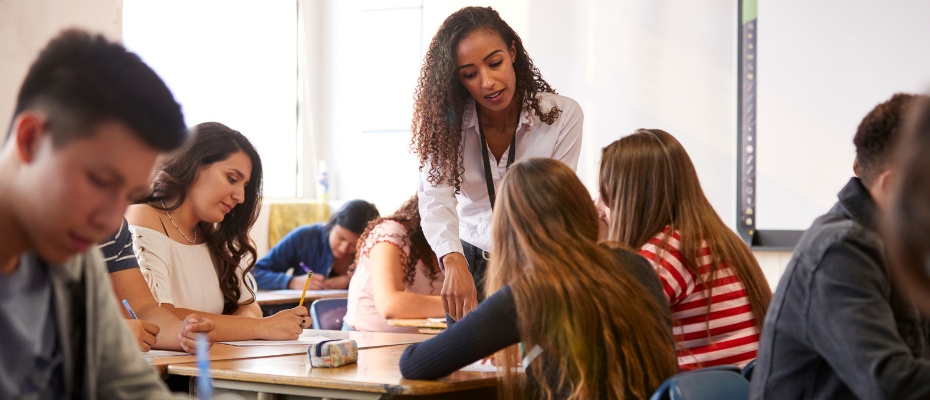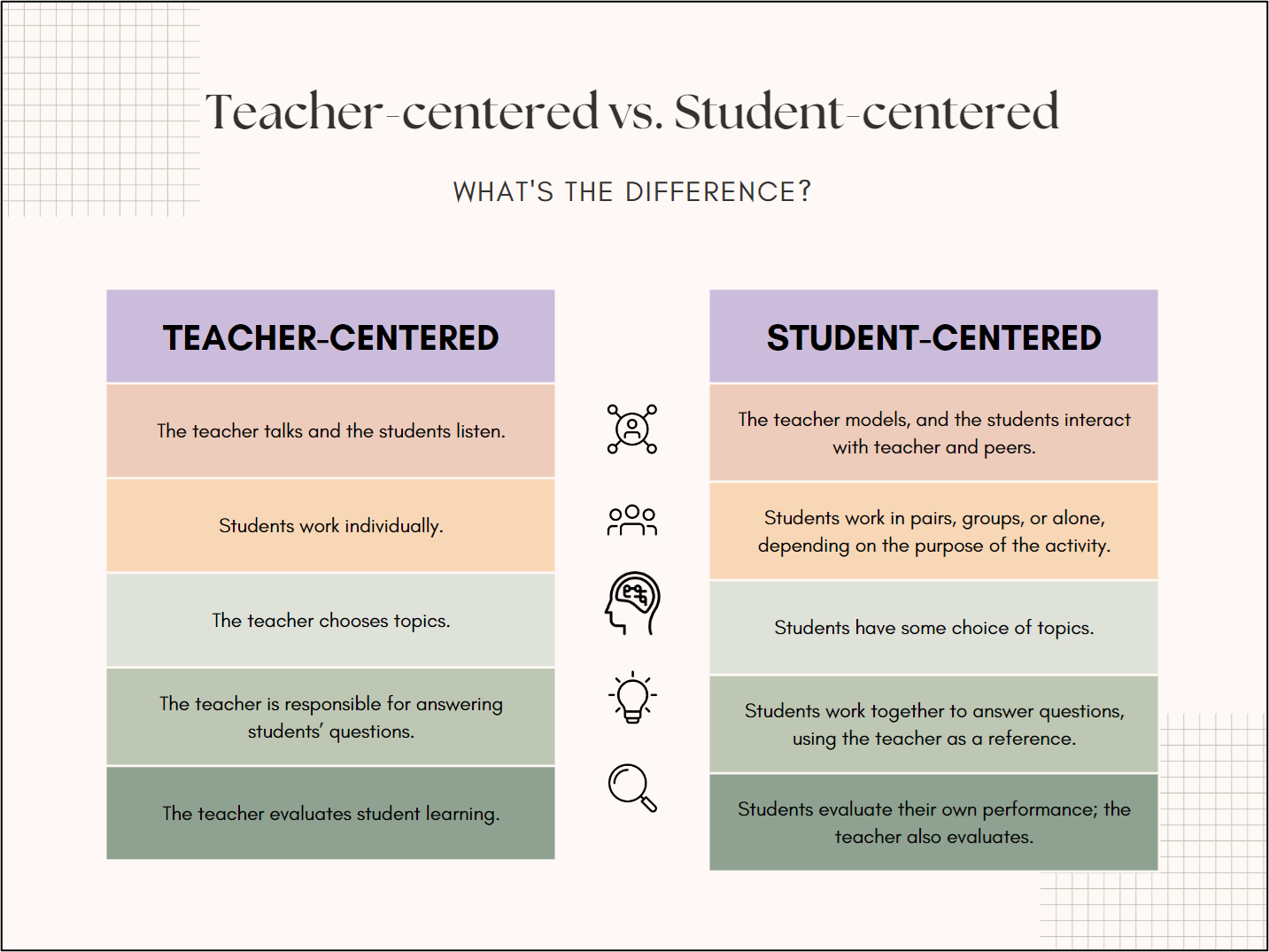Creating a Student-Centered Classroom in Grades 6-12

Meeting the needs of every student with best practices for middle school and best practices for high school that are motivating and engaging presents a formidable challenge for teachers. In recent years, teachers have been expected to accomplish more with limited resources while meeting an ever-growing list of expectations, some realistic and others not. To compound the issue, class sizes are getting larger, and basic materials are decreasing. Student-centered learning is an effective classroom management approach that encourages students to be active learners, improving student behavior and overall learning.
What does a student-centered classroom look like?
Empowering students is crucial for their success in learning. Many mistakenly assume that a student-centered approach solely focuses on the student, not the teacher. However, the focus is on the student as a learner, with teachers working hard to enhance student learning and promote success rather than just transmitting information. In a student-centered classroom, the goal is to increase student engagement and motivation, resulting in a completely different learning experience than a traditionally teacher-centered one. The graphic below highlights some of the key differences between these two approaches.

Student-centered learning is an approach that involves putting the student at the forefront of the learning process. That means students are encouraged to explore their interests and incorporate them into their studies. In this approach, learning is a collaborative effort between the teacher and the student, where students share in decision-making and leadership in the classroom. The material and curriculum provided are appropriately challenging and relevant to the student's interests, resulting in students who are motivated and engaged in the classroom. Students take an active role in their learning and develop critical thinking skills, problem-solving strategies, and the ability to work independently. This approach effectively enhances student engagement, motivation, and overall achievement.
What types of activities are appropriate for a student-centered classroom?
Here are some strategies you can implement to foster a student-centered community in your classroom alongside maintaining a classroom where students can successfully learn.
- Facilitate active learning. Students are not empty vessels that teachers fill with facts and information. Rather, “The best learning experiences are interactive. These hands-on lessons allow students to move around and use multiple senses. They require students to engage, discuss, draw, build, and collaborate. And they support deeper understanding, better retention, and increased skill fluency” (Lisciandrello, n.d.). Active learning requires the learner to be present in the learning process rather than passively listening to the teacher. However, the teacher’s guidance is still vital in the active learning classroom. Active learning activities can take anywhere from a few minutes to multiple class sessions and may involve the entire class or individual learners. As examples, the following activities actively engage students in their learning.
- Group discussions offer students opportunities to listen, think critically, and speak in response to learned content.
- Problem-solving by identifying a complex problem, gathering relevant information, connecting understanding and learning to the problem, evaluating strategies, and implementing solutions to develop a meaningful and lasting solution.
- A case study is an interactive learning method in which students analyze a pre-defined data set, scenario, or application. The students are provided with questions that help them reflect on the information they learned and then respond to it. This approach enables students to apply theoretical knowledge to practical situations and develop problem-solving skills.
- Role-playing promotes critical thinking by engaging students with complex topics and diverse perspectives in a fun way.
- Establish a community of individuals committed to learning and growing together. A healthy community is one where individuals understand and respect one another and engage in collaboration. In a student-centered community, the teacher and students are actively involved in authentic, participatory, and relevant learning experiences tailored to the students' unique needs. This type of learning creates a sense of camaraderie and mutual respect among students and teachers, fostering trust and inclusivity. By engaging in these learning experiences, students develop the skills they need to succeed. Additionally, they become more aware of the diverse perspectives and experiences of others, which helps them to develop empathy and compassion. Include content-connected texts in the classroom for students to read where students can see themselves represented. Also, teachers can achieve community by implementing the following.
- Involve students in the classroom design process to increase their ownership and engagement. Have them create maps in groups to brainstorm what the learning space might look like. Combine the best elements from each class to construct a cohesive and effective student-centered learning space.
- Create community agreements. Instead of listing rules on the syllabus at the beginning of the year, prompt students to think about how they want to be treated and what they need from their peers, the teacher, and themselves to learn effectively. Create a poster of classroom agreements that students sign their names to.
- Include opportunities for students to collaborate and explain concepts to each other, receive peer feedback, and use collaborative learning strategies like think-pair-share, small group discussions, and literature circles.
- Create space for student opinions and preferences. When students have choice and voice, the result is increased student engagement and learning (Lisciandrello, n.d.). Include your students in planning how the day will look. Ask them how much time they need to complete activities. What do they need reteaching on, and is more time needed to study? Give students a choice in how the learning will occur. Provide options for them, like conducting independent research, watching brief informational videos, working collaboratively while practicing skills, or sitting in a small group setting with the teacher for increased direct instruction. A great way to provide students with more choices is through student goal setting. You can offer a list of standards and allow them to determine how they will demonstrate mastery. Alternatively, you can give them a list of assignments from a unit and let them set their own deadlines (Lisciandrello, n.d). If you want to ease into student choice, offer the students a menu or a choice board. Within the choices, provide exemplary models, grading rubrics, and demonstrations to guide students toward mastery of the standards.
- Provide student-centered assessments. Assessments that allow students to identify their strengths and weaknesses throughout the learning process are always present in a student-centered classroom. By actively engaging in the critique of their own work and identifying areas needing improvement, students take ownership of their learning and become more invested in the process. This approach encourages students to take responsibility for monitoring and improving their own learning progress. The following are ways to create effective student-centered assessments.
- Set clear goals. Involve the students with the designing of the assessment task. Give students a menu or word bank of verbs related to the rigor of the assessment. Words like “create,” “argue,” and “synthesize” are higher-order thinking words.
- Teacher and students monitor and support the progress towards the goal. Create a timeline for the different steps and parts of the assessment with the students. At intervals, invite them to examine their progress and evaluate their process with collaboration, self-reflection, and peer feedback. Collaborate in identifying what they need to accomplish in order to be successful.
- Reflection and revision at completion. Create a process for the teacher and students to discuss the end-of-learning objectives and whether they have been met. In pairs or as a group, discuss how the completed assessment displays the learning, what worked, and what else may be needed for mastery. Allow for student revisions afterward, as student learning is the overall goal.
You got this!
When creating a student-centered classroom, evaluate your current classroom structure and then ask yourself, "How will this benefit my students?" When you examine your classroom through this filter, and consider the changes you plan to implement, you can guide the process toward a more student-centered learning experience. As an educator, trying new strategies and improving your teaching practices can be overwhelming. So, it is best to focus on making one small weekly change. This way, you can better support your students by implementing new strategies while still having the time to reflect and adjust based on your experiences. By taking a gradual approach, you can avoid feeling overwhelmed and ensure that you provide the best possible education for your students.
To learn more about classroom management teaching strategies, visit the Professional Development Institute (PDI) website or our Motivating and Engaging Middle and High School Students (Grades 6-12) course. For over 27 years, PDI has provided high-quality online professional development courses to K-12 educators worldwide. Our courses are designed to offer practical strategies that can be implemented in classrooms immediately while focusing on the most relevant topics in education. All our courses are instructor-led and conducted entirely online at the graduate level. University credit is also available through the University of California Division of Extended Studies. We offer an extensive catalog of online courses that cover the most critical topics in today's classrooms and are affordable for teachers.
References
Lisciandrello, J. (n.d.). “The 6 Signs of a Student-Centered Classroom.” Room to Discover. Retrieved 24 October 2023 https://roomtodiscover.com/student-centered-classroom/

View PDI's Catalog of Courses
Check out a list of all PDI graduate-level online courses or sort by grade level or subject area.

Register Now!
Quick access to register for PDI's online courses using our secure system.

Learn More about PDI
Find out how to reach PDI and get answers to any questions you may have.
